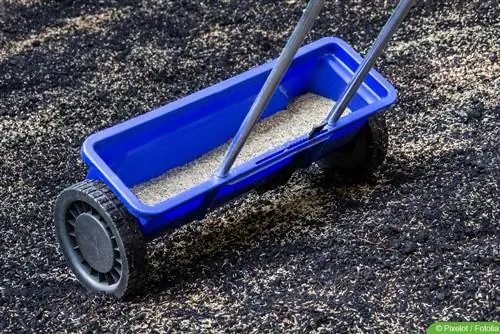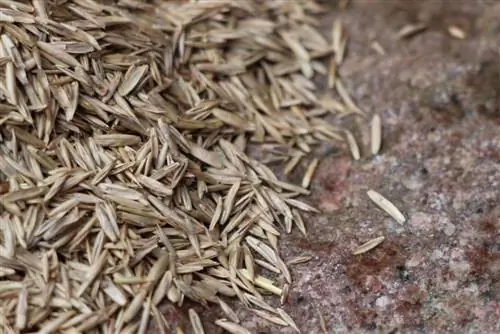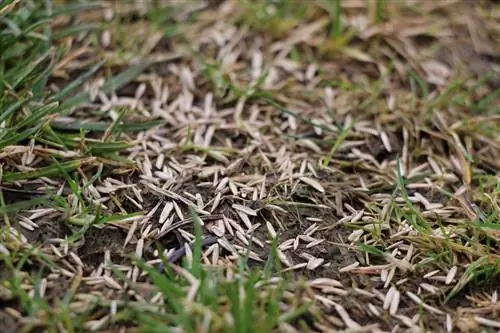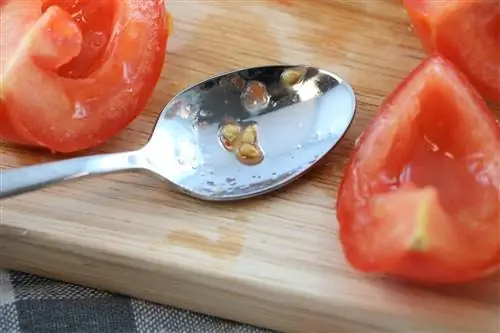- Author admin [email protected].
- Public 2023-12-17 03:39.
- Last modified 2025-01-24 12:45.
A beautiful and well-maintained lawn depends on the even sowing of grass seeds. Professional gardeners often have to practice even sowing by hand over many years. Many hobby gardeners don't have that much time, which is why they can help themselves with spreaders. The trolley not only makes sowing easier, but also helps to distribute the seeds evenly over the area.
How a gritter works
Gritters can be used in many ways in the garden. They are used to spread fertilizer, seeds or substrates. The cart usually has a setting that can be used to regulate how much grit can be spread. By adjusting the size, different sizes of grit can also be spread. Due to the forward movement, the grit later falls out of the cart. Only forward movement opens the hatches and when reversing they remain closed. This prevents grit from being spread twice on one area.
Tip:
There are models of spreaders that have color markings, which mark areas that have already been spread. Such models cost a little more, but are useful for large areas or for frequent use.
Gritters can be used all year round and not just for spreading seeds on lawns. The carts offer these usage options:
- Sowing
- Fertilize
- Sprinkle s alt
- Application of crumbly substances
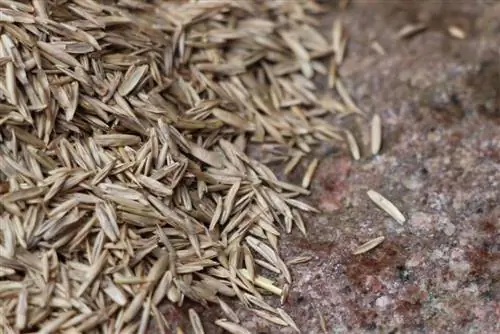
Although the cart is often used on paths and lawns, it can also be helpful in beds. When preparing the beds, the cart can be used to spread fertilizer evenly. Other products such as pesticides in the form of granules can also be distributed evenly with the trolley.
Soil preparation
Before sowing seeds with a cart, the soil must be prepared. Lawn soils are often heavily compacted areas that do not form the best basis for seeds. The soil should be loose, which is why compacted soil should first be loosened. Commercially available garden tillers can be used for this. So that the grit can be spread evenly later, the ground must be straightened again after loosening. You should definitely use a large spirit level for this. Although the floor can never be completely horizontal, larger unevenness can be prevented by measuring. To ensure that the soil remains flat, it is compacted slightly with a roller.
Choose seeds
Before the grass seed is spread, a suitable mixture must be selected. From sports turf to English lawn, there are different mixtures with grass seeds. The mixtures differ in the composition of the grasses. The grass mixture for English lawns, for example, is not as durable as grasses for sports fields. The selection of seeds depends on the later use. There are ready-made mixtures available in stores, for example for recreational lawns. Lawn mixtures can also be put together individually in specialist shops. This means that the grass mixture can be adapted to a specific use or the soil or climate conditions.
Tip:
A grass mixture for a recreational lawn is usually the most popular choice. It is robust and easy to care for.
Prepare seeds
While no further preparation is required when spreading by hand, the grass seeds are usually too small for spreaders. The quantity cannot be set so small that too much seed cannot be spread at certain points. The lawn seed must therefore be mixed with a different substrate. The seeds can be mixed with different substrates. For example:
- Sand
- fine crumbly compost
- Fertilizer
When mixing with fertilizer, care must be taken, especially for new plants, to ensure that the soil does not become too nutrient-rich. For example, mineral fertilizers that are mixed with the seeds are suitable. If compost is used, care must be taken to ensure that the soil is dry and very finely crumbly. Otherwise there may be problems with spreading and the soil may clog the openings of the cart. A mixture can also consist of several parts. The seeds can be mixed with sand and compost, which creates an even more even picture when sowing.
Use the spreader
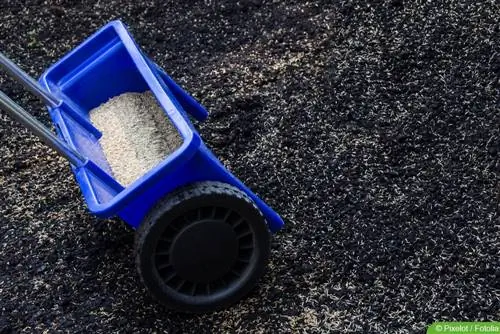
After the seeds have been mixed, the cart can be filled. To do this, proceed as follows:
- Setting the spreading rate
- Fill the car
- Spread seeds evenly
- Mark sown areas
Tip:
Only set the spreading amount on the trolley to half. After the first round, the area is walked again across the direction of sowing, which creates a more even picture.
After sowing
Depending on the mixture, the seeds will germinate within a few days. During this time, the soil should remain constantly moist and not dry out. Drought causes the sensitive seedlings to die. Although the seed is spread evenly with the spreader, it can happen that there are places where no seeds germinate. In this case, the cart is walked over the area in question again. The topsoil or the addition of compost to the seeds usually provides the seedlings with enough nutrients to grow well. After about three weeks, the advantages of a spreader become apparent because it can now be used to spread fertilizer.

